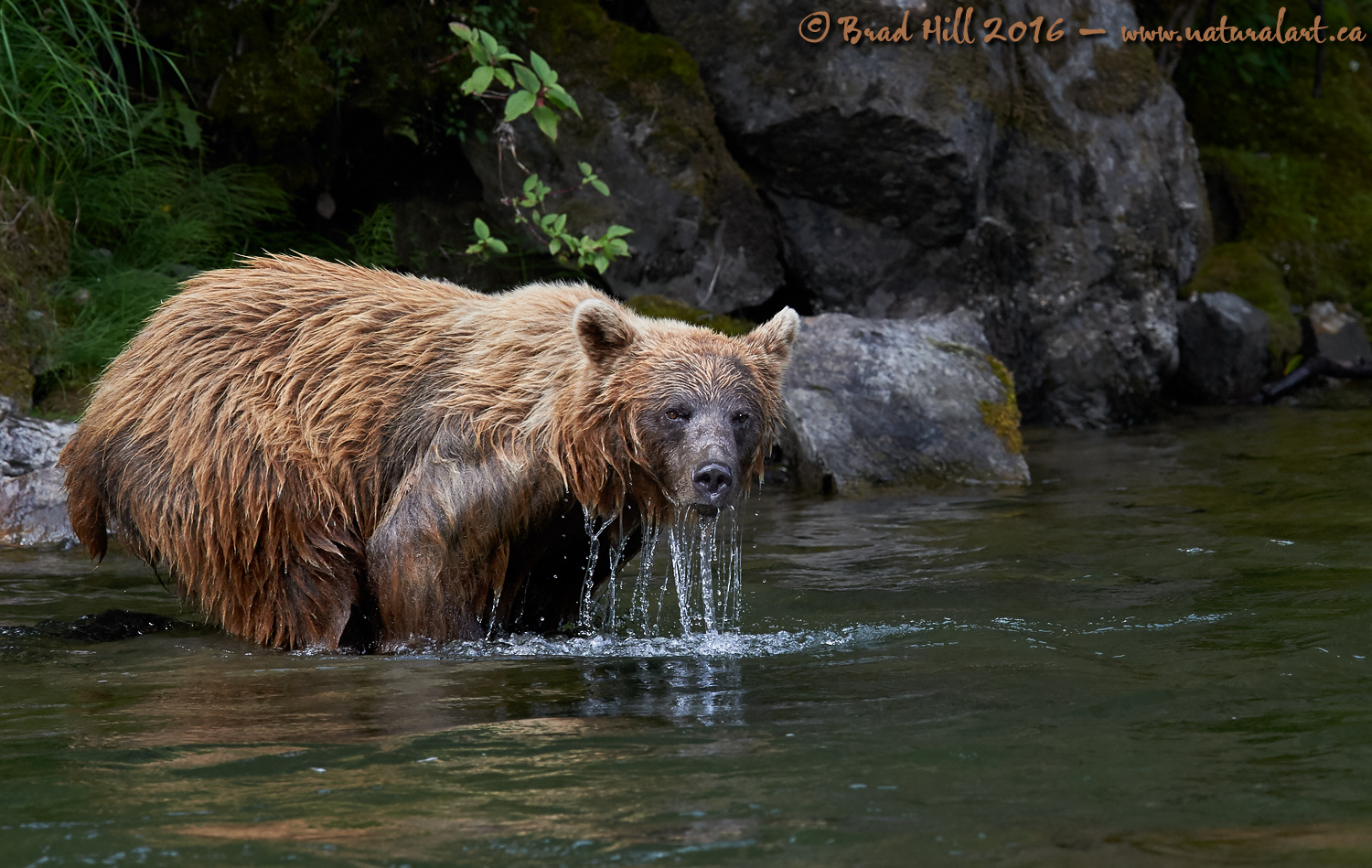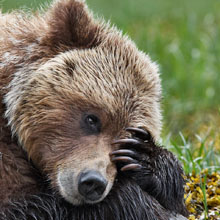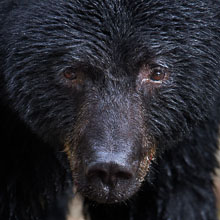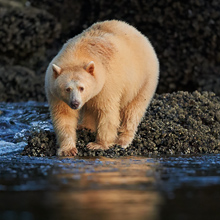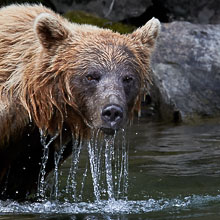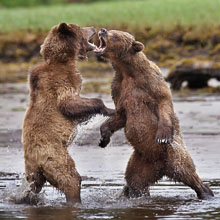Availability: Undetermined - Enquiries?
In the Field
The Water Beard. Taku River Drainage, northern British Columbia, Canada. July 28, 2015.
Virtually all genres of modern photography are about capturing decisive moments (and often even critical split seconds) of time. It's always been this way - since the very day cameras were invented. Some would argue that any this is particularly true in wildlife photography - and the difference between a good wildlife photo and a GREAT wildlife photo is often only a matter of milliseconds.
The advent of faster and faster frame rates on our digital cameras (and the fact that high frame rates are "trickling down" to lower priced cameras) hasn't changed this basic fact of photography life. Almost paradoxically, I've actually seen a DECREASE in the attention photographers pay to capturing "just the right moment" as high frame rate (and large burst-size) cameras become more common. Instead, there seems to be this attitude among some shooters that if they just keep continuously firing at a high frame rate they'll "capture absolutely everything" and, equally importantly, "miss nothing at all". What they fail to realize is that by keeping their eye glued to the viewfinder (as they blaze away) they end up missing so many of the "wider" scenes, as well as losing the ability to predict action and other interesting "decisive moments" that may take place outside their relatively narrow field of view (such as when another bear begins encroaching on the scene and fur may be about to fly).
It's my experience that this "just keep the shutter flying" style of shooting produces a whole lot of those ho-hum "more-of-the-same" style shots that eat valuable time when you have to cull through them on your computer. This past autumn I watched a photographer shoot over 40 images (at over 10 fps) of the butt of a bear that didn't move once during her entire burst. I guess the bear may have had a nice butt...but 40+ images of it? Why? Must have been fun culling through those images looking for the best butt shot among over 40 similars.
I captured this image of water streaming off a female grizzly's face while she was employing her own special "look under the water" fishing technique (every bear seems to have its own preferred way of fishing). I had noticed that this bear almost always gave a super fast glance over in our direction as she raised her head after dunking it to take a look for fish. I suspect she was doing this just to keep tabs on us...but that quick sideways glance (and the eye contact) never lasted more than a fraction of a second and if you didn't start shooting at just the right time you'd miss the combined eye contact and streaming water. I watched the sequence a few times before shooting and, when I did, I timed it to capture the glance and the maximum amount of streaming water coming off the bear. I had a total of 10 images to cull through before choosing this one to process.
The take home lesson? Obviously there's times when it makes sense to "let it rip" and shoot high-speed bursts of action. But doing it perpetually - or even the majority of the time - may mean you miss a LOT of good shots, and often the BEST shots available at the time. Shooting selectively is never a bad strategy. Shooting bursts is fine too, but in my view shooting even those selectively can be a better overall strategy than just "sitting" on the shutter! It's amazing what you can see when you stop shooting for a few seconds and look around!
Here's a higher-resolution (2400-pixel) version of this shot that shows the streaming water even better:
• The Water Beard: Download 2400 pixel image (JPEG: 1.6 MB)
ADDITIONAL NOTES:
1. This image - in all resolutions - is protected by copyright. I'm fine with personal uses of them (including use as desktop backgrounds or screensavers on your own computer), but unauthorized commercial use of the image is prohibited by law. Thanks in advance for respecting my copyright!
2. Like all wildlife images on this website, the subject(s) is/are fully wild and completely unconstrained. Besides the potential impact of my/our presence, nothing has been done to intentionally alter or affect the ongoing behavior of the subject and, of course, there has been no use of any form of bait or other form of wildlife attractants (including vocalizations or other sounds).
3. This image was captured my August "Fishing Grizzlies of the Taku" photo tours in 2015. Each year I offer trips into two different parts of the Great Bear Rainforest as well as one to photograph marine mammals and oceanscapes near the northern tip of Vancouver Island. And, in selected years, I also offer photo tours to additional locations to capture other highly sought-after subjects, such as various boreal owl species, fishing grizzlies, and more. Details about these trips can be found on the Photo Tours page of this website.
Behind the Camera
The Water Beard. Taku River Drainage, northern British Columbia, Canada. July 28, 2015.
Digital Capture; Compressed RAW (NEF) 14-bit format; ISO 1600.
Nikon D4s paired with Nikkor 400mm f2.8E VR plus TC-14EIII (1.4x) teleconverter, for a total focal length of 550mm. Hand-held. VR on and in "Sport" mode.
1/1250s @ f6.3; -0.67 stop compensation from "recommended" matrix-metered exposure setting.
At the Computer
The Water Beard. Taku River Drainage, northern British Columbia, Canada. July 28, 2015.
RAW Conversion to 16-bit TIFF using Phase One's Capture One Pro 8. Four raw variants (different versions of a single raw capture) processed, with the variants differing in exposure (0.8 stop total difference between the variants) and both shadow retrieval and highlight recovery settings.
Further digital corrections on resulting 16-bit TIFF files using Adobe's Photoshop CC 2015 and Light Crafts Lightzone. Photoshop adjustments included compositing (blending) of the four output files from the raw converter, minor exposure tweaks, and final selective sharpening for web output. Final tone-tweaking performed using LightZone's "tonemapper" tool.
Conservation
The Water Beard. Taku River Drainage, northern British Columbia, Canada. July 28, 2015.
Ten percent of the revenue generated by this image will be donated to Raincoast*.
Species Status in Canada**: Special Concern (May 2002).
While Grizzly Bears (Ursus arctos) are not technically listed as "Endangered" in Canada, they have been extirpated from most of their historical range. Grizzly Bears are far more sensitive to intrusion/disturbance in their habitat than are Black Bears and are being increasingly forced into marginal habitat by human encroachment. The Great Bear Rainforest along the central and northern coast of British Columbia is one of the last strongholds of the Grizzly Bear in Canada, and even this population is coming under increasing pressure.
On December 18, 2017 the government of British Columbia banned grizzly hunting across the entire province. This major conservation victory came after decades of tireless work by many dedicated conservationists and ecologists and, most importantly, it reflects the opinion of the vast majority of British Columbians. And, it means that AT LEAST while the current government remains in power grizzlies are finally "safe" in British Columbia.
Now that we've at least temporarily won the battle to save grizzlies in BC, it's time to re-focus our efforts toward protecting ALL of BC's carnivores, including Gray Wolves, Black Bears, Cougars, Wolverines, and more! Simply put, there are no ecological, economic, or ethical arguments supporting the trophy hunting of carnivores.
In a great first step towards ending the hunting of carnivores throughout BC the Raincoast Conservation Foundation has developed a program designed to protect ALL carnivores within the Great Bear Rainforest. Details about this program can be found on this page on Raincoast's website. Check it out and, better yet, make a donation to help Raincoast purchase the remaining commercial hunting tenures in the Great Bear!
*The Raincoast Conservation Society (and Foundation) is an effective and efficient organization that has been fighting for protection of this unique habitat. If you are looking for a meaningful way to contribute to the conservation of this amazing ecosystem, Raincoast will provide maximal "bang" for your conservation dollars.
**as determined by COSEWIC: The Committee on the Status of Endangered Wildlife in Canada












